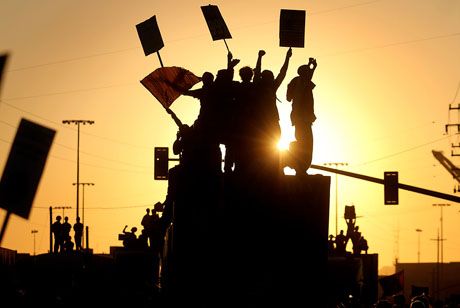Features
You are here
Quebec student strike shows the way to fight fees

February 27, 2012
As we go to press, over 65,000 striking Quebec university and college students have shut down their campuses to protest Quebec government plans to raise tuition fees by $1,625 over the next five years. They are motivated by some important past victories won through the determination and organization of the Quebec student movement.
From 1968 to 1990, tuition fees in Quebec were frozen at $500 a year. After a hike of about 150 per cent from 1990 to 1993, a PQ government introduced a new freeze in 1994. But that same government opened the door to a new increase in the name of deficit cutting in 1996. It faced a Quebec-wide student strike with mass street protests and gave up that idea. Fees have also increased by $100 a year over the past five years under the Charest government.
Today’s strike comes only seven years after the last one. In 2005, an unlimited student strike shut down nearly every post-secondary institution in Quebec to protest the cutting of $103 million from bursaries to convert them into loans. The students won, forcing the government to backtrack on a policy it had already passed. That strike received massive public support and was the source of the “red square” badge, worn by thousands of students and supporters, which is also in use today.
Strike organization
The strike of 2005 was, like all student strikes in Quebec’s history, organized through mass student assemblies to hold strike votes. In January and February of this year the strike was voted on in mass assemblies, faculty by faculty in some universities, and at colleges (CEGEPs) across Quebec.
Quebec students use a strike vote threshold approach (first used in the 1986 strike) to establish an official start of the strike on each campus. A threshold of 20,000 students in at least seven student unions and on at least three campuses was established for many student unions, and that threshold was met on February 9. Strike votes have continued since then in other faculties and on other campuses, and other, more ambitious thresholds have been met and triggered additional walkouts (for details, see bloquonslahausse.com).
But all of the walk-outs, no matter when they start, are unlimited (or renewable, usually every three days). So the ranks of the strike continue to grow, and will reach its height over the course of March.
The strike votes were initiated by the Coalition large de l’Association pour une solidarité syndicale étudiante (CLASSE), with over 40,000 members, but the strike will soon be joined by members of the Fédération étudiante universitaire du Québec (FEUQ, which has 125,000 members) and the Fédération étudiante collégiale du Québec (FECQ, which has 80,000 members).
On February 23, about 1,000 students shut down the Jacques Cartier Bridge in Montreal during afternoon rush hour, as part of a demonstration of 15,000 people. As they made their way to the bridge, the police aggressively confronted the march, breaking it up with pepper spray, and arresting at least one student.
Solidarité
The success of all of the Quebec student strikes to date has involved not only walk-outs but public demonstrations of strength—whether it be picketing in front of campuses, staging mass demonstrations in the streets, launching sit-ins or occupations of the Ministry of Education and other government offices, and other direct action like street blockades. These actions have received wide support by the Quebec population in the past as a legitimate part of making the strikes a success. But the English Canadian media, including the CBC, has undermined the students’ message and defended the police repression at the Bridge blockade.
We have a responsibility to show visible support outside Quebec for the students’ struggle. There is a call for solidarity actions with the Quebec strike on March 13: contact your local student union and voice your support for some kind of action on that day. Our support could make a difference to the outcome, and a victory for Quebec students could inspire resistance to tuition hikes across the country.
Section:
- Log in to post comments










